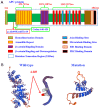A novel APC mutation identified in a large Chinese family with familial adenomatous polyposis and a brief literature review
- PMID: 29901124
- PMCID: PMC6072187
- DOI: 10.3892/mmr.2018.9130
A novel APC mutation identified in a large Chinese family with familial adenomatous polyposis and a brief literature review
Abstract
Familial adenomatous polyposis (FAP), an autosomal dominant disease, is a colon cancer predisposition syndrome that manifests as a large number of adenomatous polyps. Mutations in the Adenomatous polyposis coli (APC) gene are responsible for the majority of cases of FAP. The purpose of the present study was to report the clinical features of a Chinese family with FAP and screen for novel mutations using the targeted next‑generation sequencing technology. Among the 29 family members, 12 were diagnosed of FAP. Based on an established filtering strategy and data analyses, along with confirmation by Sanger sequencing and co‑segregation, a novel frameshift mutation c.1317delA (p.Ala440LeufsTer14) in exon 10 of the APC gene was identified. To the best of our knowledge, this mutation has not been reported prior to the present study. In addition, it was correlated with extra‑colonic phenotypes featuring duodenal polyposis and sebaceous cysts in this family. This novel frameshift mutation causing FAP not only expands the germline mutation spectrum of the APC gene in the Chinese population, but it also increases the understanding of the phenotypic and genotypic correlations of FAP, and may potentially lead to improved genetic counseling and specific treatment for families with FAP in the future.
Figures




Similar articles
-
Mutational screening through comprehensive bioinformatics analysis to detect novel germline mutations in the APC gene in patients with familial adenomatous polyposis (FAP).J Clin Lab Anal. 2021 May;35(5):e23768. doi: 10.1002/jcla.23768. Epub 2021 Mar 26. J Clin Lab Anal. 2021. PMID: 33769591 Free PMC article.
-
A novel pathogenic germline mutation in the adenomatous polyposis coli gene in a Chinese family with familial adenomatous coli.Oncotarget. 2015 Sep 29;6(29):27267-74. doi: 10.18632/oncotarget.4776. Oncotarget. 2015. PMID: 26311738 Free PMC article.
-
A novel pathogenic splice acceptor site germline mutation in intron 14 of the APC gene in a Chinese family with familial adenomatous polyposis.Oncotarget. 2017 Mar 28;8(13):21327-21335. doi: 10.18632/oncotarget.15570. Oncotarget. 2017. PMID: 28423518 Free PMC article.
-
APC germline mutations in individuals being evaluated for familial adenomatous polyposis: a review of the Mayo Clinic experience with 1591 consecutive tests.J Mol Diagn. 2013 Jan;15(1):31-43. doi: 10.1016/j.jmoldx.2012.07.005. Epub 2012 Nov 14. J Mol Diagn. 2013. PMID: 23159591 Review.
-
Correlations between mutation site in APC and phenotype of familial adenomatous polyposis (FAP): a review of the literature.Crit Rev Oncol Hematol. 2007 Feb;61(2):153-61. doi: 10.1016/j.critrevonc.2006.07.004. Epub 2006 Oct 24. Crit Rev Oncol Hematol. 2007. PMID: 17064931 Review.
Cited by
-
Novel compound heterozygous PKHD1 mutations cause autosomal recessive polycystic kidney disease in a Han Chinese family.Mol Med Rep. 2019 Dec;20(6):5059-5063. doi: 10.3892/mmr.2019.10738. Epub 2019 Oct 11. Mol Med Rep. 2019. PMID: 31638247 Free PMC article.
-
First Evidence of Familial Transmission of Hereditary Gastrointestinal Polyposis Associated with Germline APC Variant in Jack Russell Terriers.Vet Sci. 2023 Jul 5;10(7):439. doi: 10.3390/vetsci10070439. Vet Sci. 2023. PMID: 37505844 Free PMC article.
-
Mutational screening through comprehensive bioinformatics analysis to detect novel germline mutations in the APC gene in patients with familial adenomatous polyposis (FAP).J Clin Lab Anal. 2021 May;35(5):e23768. doi: 10.1002/jcla.23768. Epub 2021 Mar 26. J Clin Lab Anal. 2021. PMID: 33769591 Free PMC article.
-
Advances in Identification of Susceptibility Gene Defects of Hereditary Colorectal Cancer.J Cancer. 2019 Jan 1;10(3):643-653. doi: 10.7150/jca.28542. eCollection 2019. J Cancer. 2019. PMID: 30719162 Free PMC article. Review.
-
Novel compound heterozygous DNAAF2 mutations cause primary ciliary dyskinesia in a Han Chinese family.J Assist Reprod Genet. 2020 Sep;37(9):2159-2170. doi: 10.1007/s10815-020-01859-7. Epub 2020 Jul 7. J Assist Reprod Genet. 2020. PMID: 32638265 Free PMC article.
References
MeSH terms
Substances
LinkOut - more resources
Full Text Sources
Other Literature Sources
Miscellaneous

